Biggest increase since June 2021. And they mostly bought long-term Treasury debt. No major holder dumped.
By Wolf Richter for WOLF STREET.
All foreign investor entities combined, from central banks to private investors, massively bought US Treasury securities, increasing their holdings by $290 billion in February, the second largest month-to-month increase in the data going back to 2011, and the largest increase since June 2021, bringing their total holdings to a record $8.82 trillion. Compared to a year ago, their holdings soared by $818 billion (red line in the chart).
And they mostly bought long-term Treasury securities: Their holdings of them increased by $217 billion in February, the biggest increase since June 2021, to $7.5 trillion, showing strong interest and confidence in long-term Treasury debt. The data was released by the Treasury Department today.
The buying was across the board, with all major holders adding to their positions: The top six financial centers combined (UK, Belgium, Luxembourg, Switzerland, Cayman Islands, Ireland = blue), the Euro Area (green), Japan, (gold), China and Hong Kong (purple), along with the other major holders not shown in the chart, Canada, Taiwan, India, and Brazil.
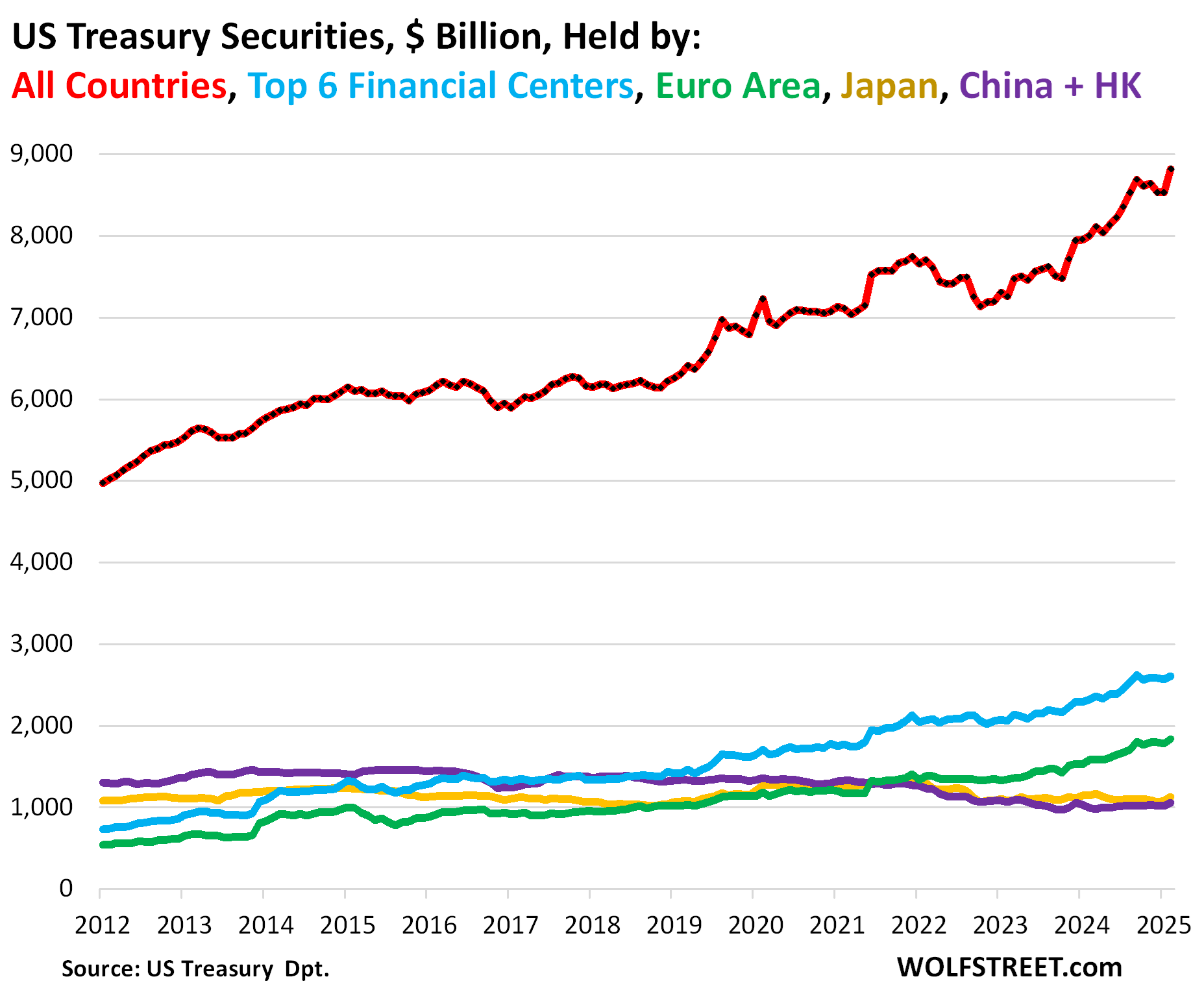
Higher yields create demand. Yields of US Treasury securities have remained relatively high compared to the securities of other countries. The 10-year Treasury yield is currently at 4.28%, compared to the German 10-year yield of 2.51%, the Japanese 10-year yield of 1.20%, or the Canadian 10-year yield of 3.08%. One of the exceptions is the UK 10-year yield, at 4.61%.
These higher yields for Treasury securities make them very attractive to foreign buyers. We saw that this buying continued at the 10-year and 30-year Treasury auctions last week, and at the 20-year Treasury auction today: There was blistering demand from “indirect bidders,” a category that includes foreign bidders.
Euro Area v. China + Hong Kong.
China and Hong Kong combined added $41 billion to their holdings in February, bringing them to $1.05 trillion. Over the past 12 months, they’ve added $66 billion to their holdings. But since the 2015 peak, they’ve shed nearly one-third of their holdings (blue).
The countries of the Euro Area added $52 billion in February and $253 billion over the past 12 months, bringing their holdings to a record $1.83 trillion. The tightly-knit currency and economic area is the largest holder of US Treasury debt, and the largest creditor of the US.
The biggest holders in the Euro Area are the financial centers (Luxembourg, Ireland, Belgium, see further below) and France, whose banking system also functions as a global financial center.
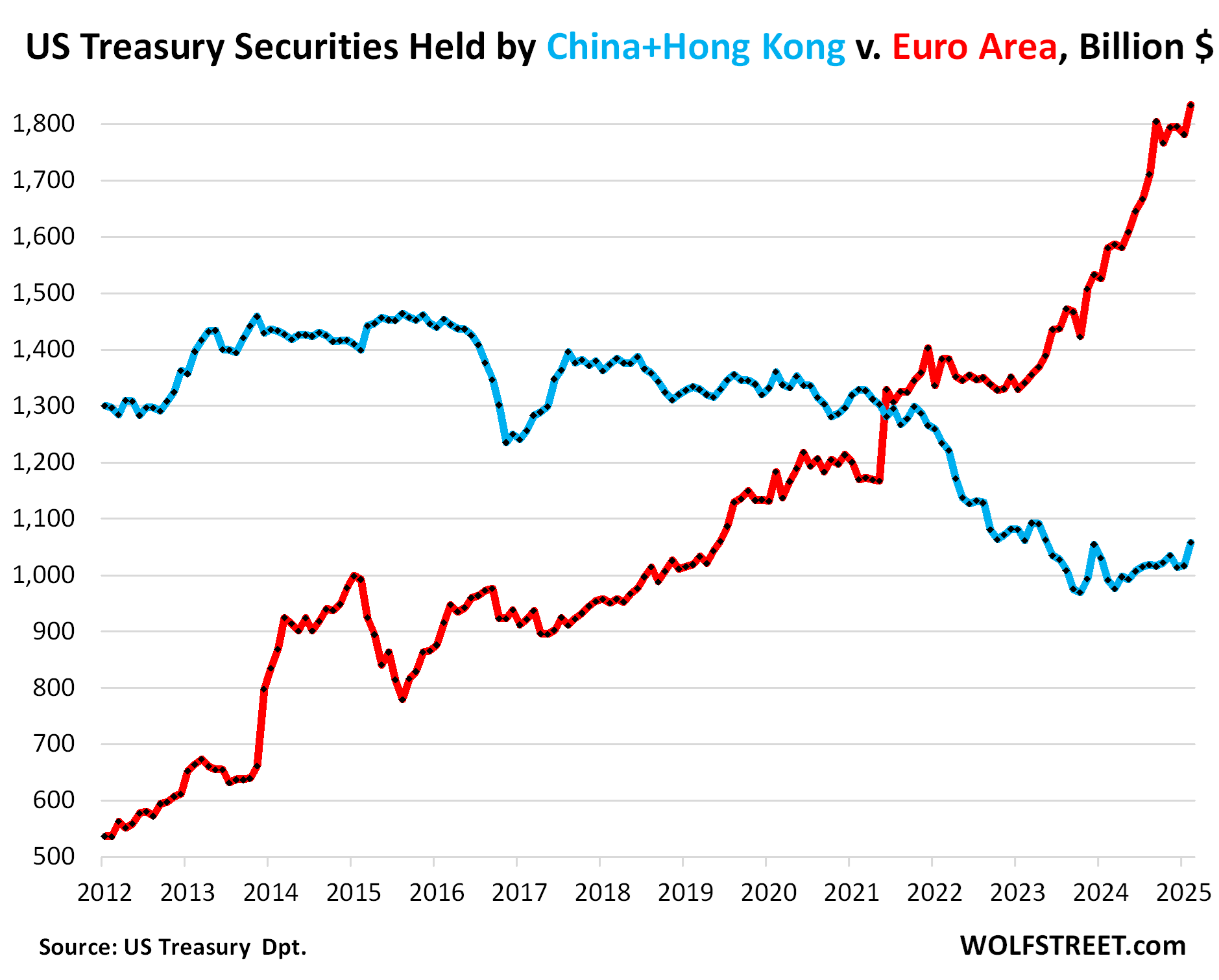
Japan’s holdings jumped by $47 billion in February. It thereby recaptured nearly all the declines since April 2024 that resulted from its efforts to prop up the yen, which had plunged.
Since 2012, Japan’s Treasury holdings rose and fell, and currently are where they were in 2012:
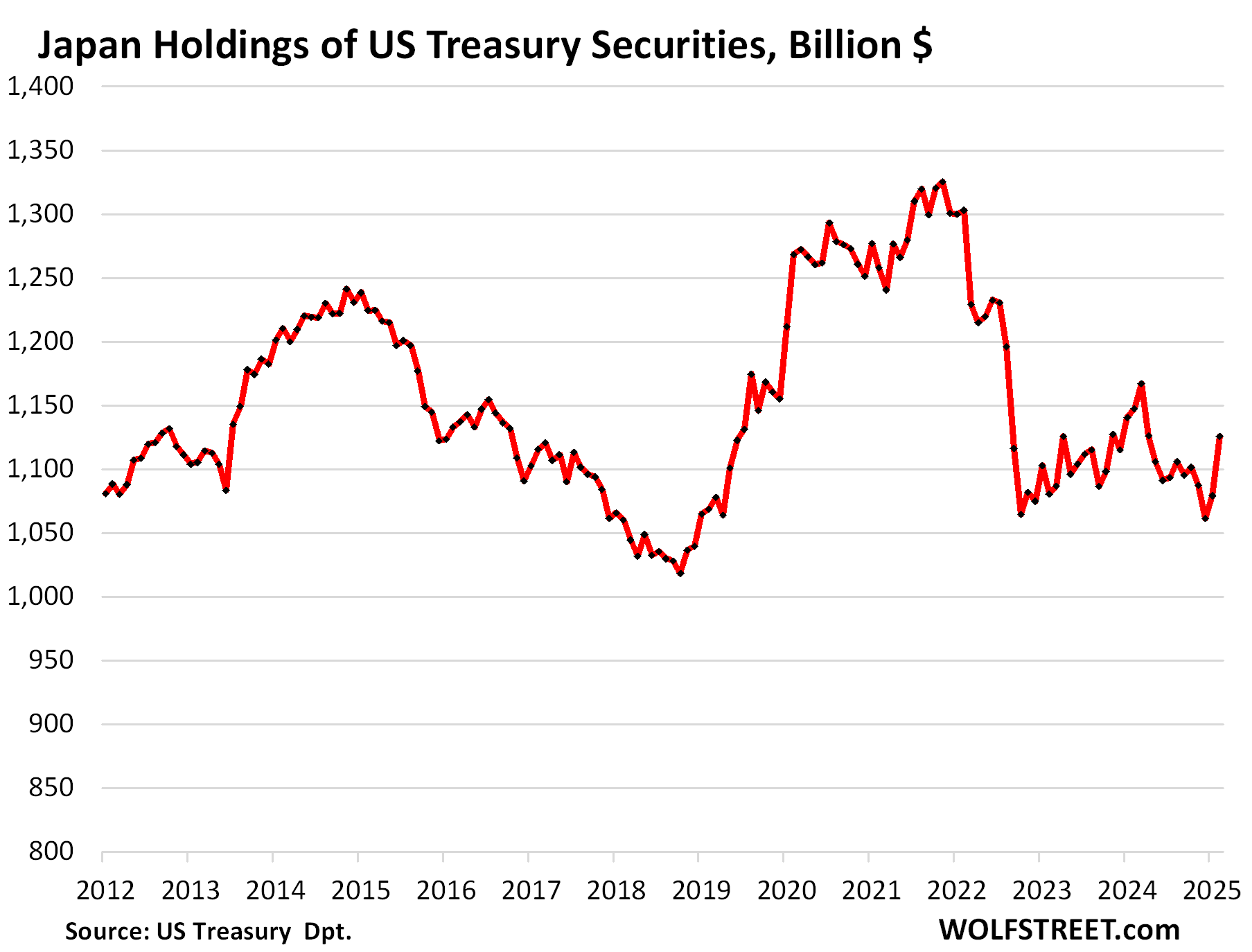
The six largest financial centers added $42 billion in Treasury securities in February (+1.6%) and $285 billion over the past 12 months, to $2.60 trillion, just a hair below the record of September 2024. Since 2012, their holdings have more than tripled!
These countries specialize in handling the financial holdings of global companies, individuals, and governments. Ireland is a favorite for US Big Pharma and Big Tech to store their profits. So a portion of the holdings at these financial centers are actually held for US entities, and not by foreign investors. The United Kingdom here is the “City of London,” one of the top financial centers in the world.
Increases in February, and total holdings. Switzerland was the only exception:
- United Kingdom: +$10 billion, to $750 billion
- Luxembourg: +$3 billion, to $412 billion
- Cayman Islands: +$13 billion to $418 billion
- Ireland: +9 billion to $339 billion
- Belgium (home of Euroclear): +$17 billion to $395 billion
- Switzerland: -$10 billion to $291 billion.
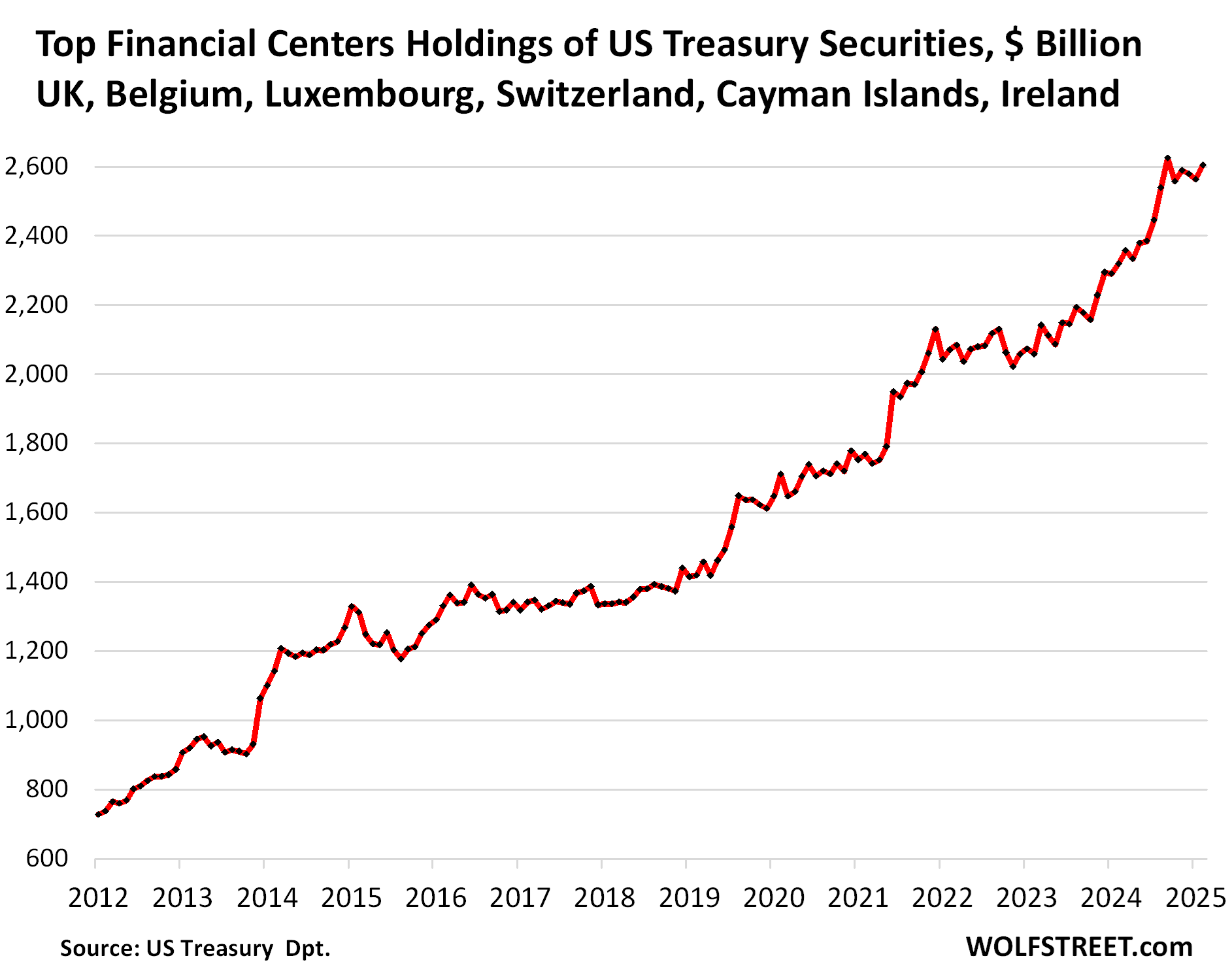
The United Kingdom added $10 billion in February and $39 billion over the past 12 months, bringing its holdings to $750 billion. The UK is also included in the list above of the top 6 financial centers, but it’s by far the biggest and deserves its own chart:
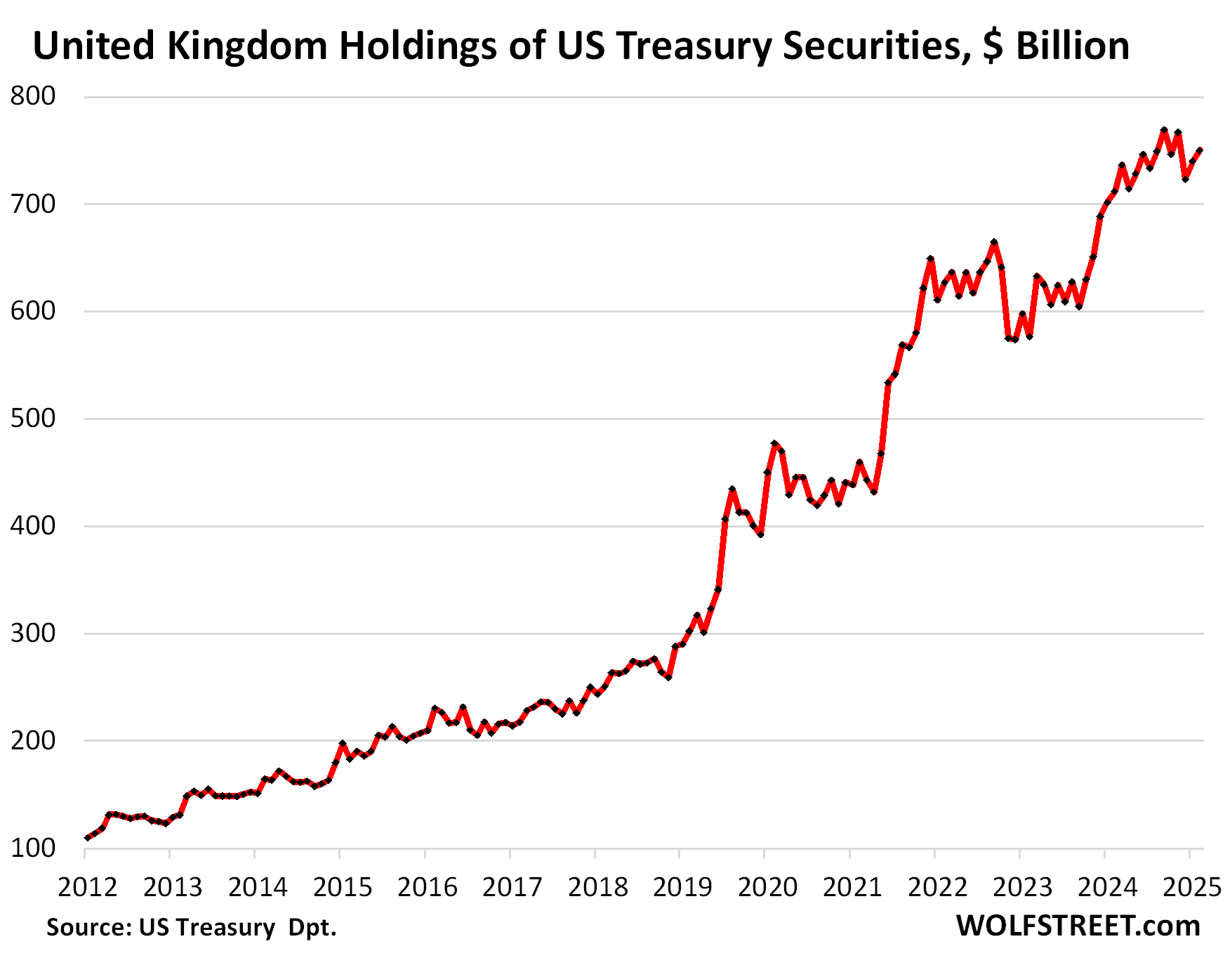
Canada’s holdings spiked by $55 billion in February, bringing them to a record $406 billion. Since March 2021, holdings have nearly quadrupled! Since 2012, holdings have octupled!
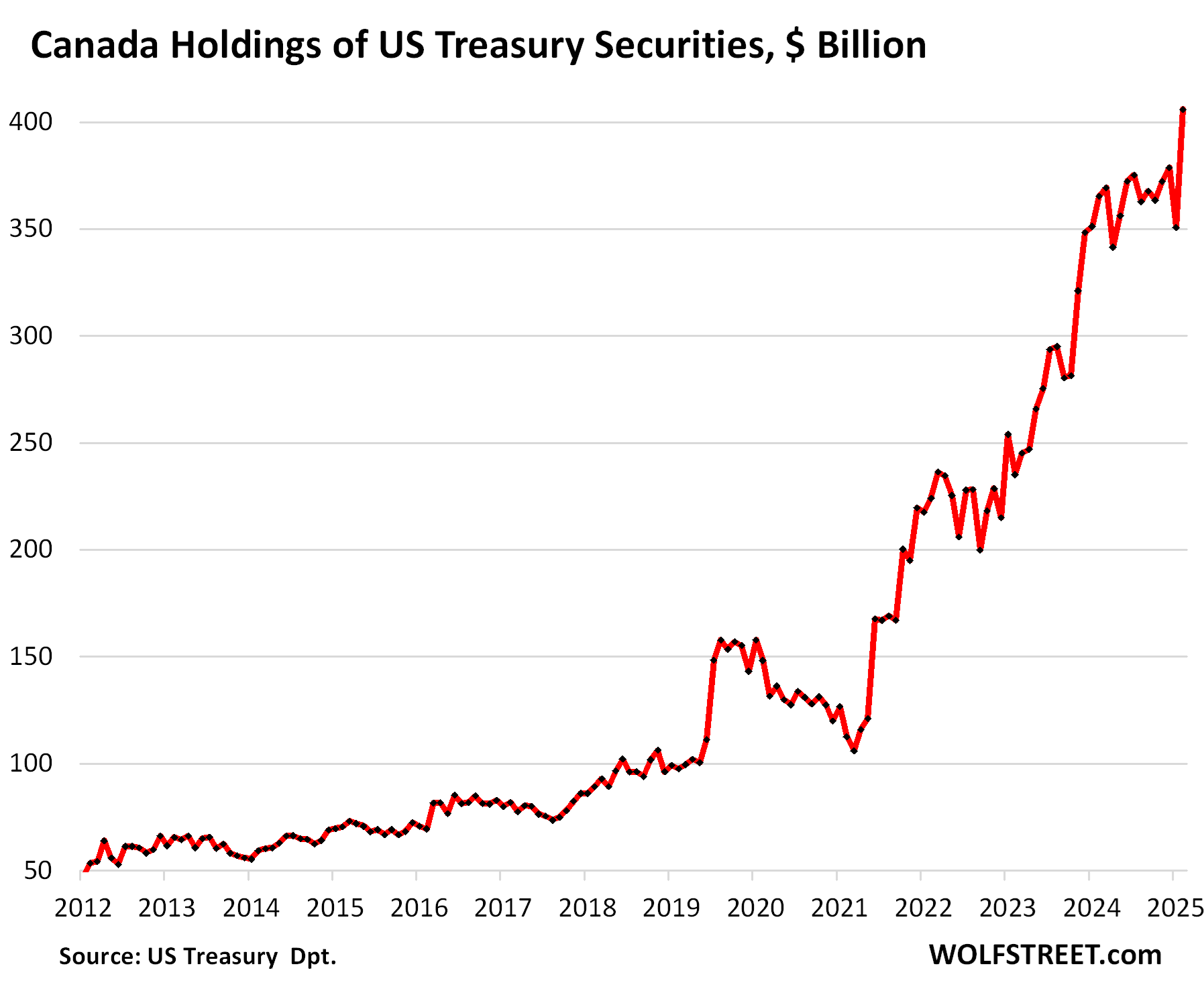
France’s holdings jumped by $17 billion in February, and by $83 billion from a year ago, to a record $354 billion. Banking in Paris also functions as a financial center.
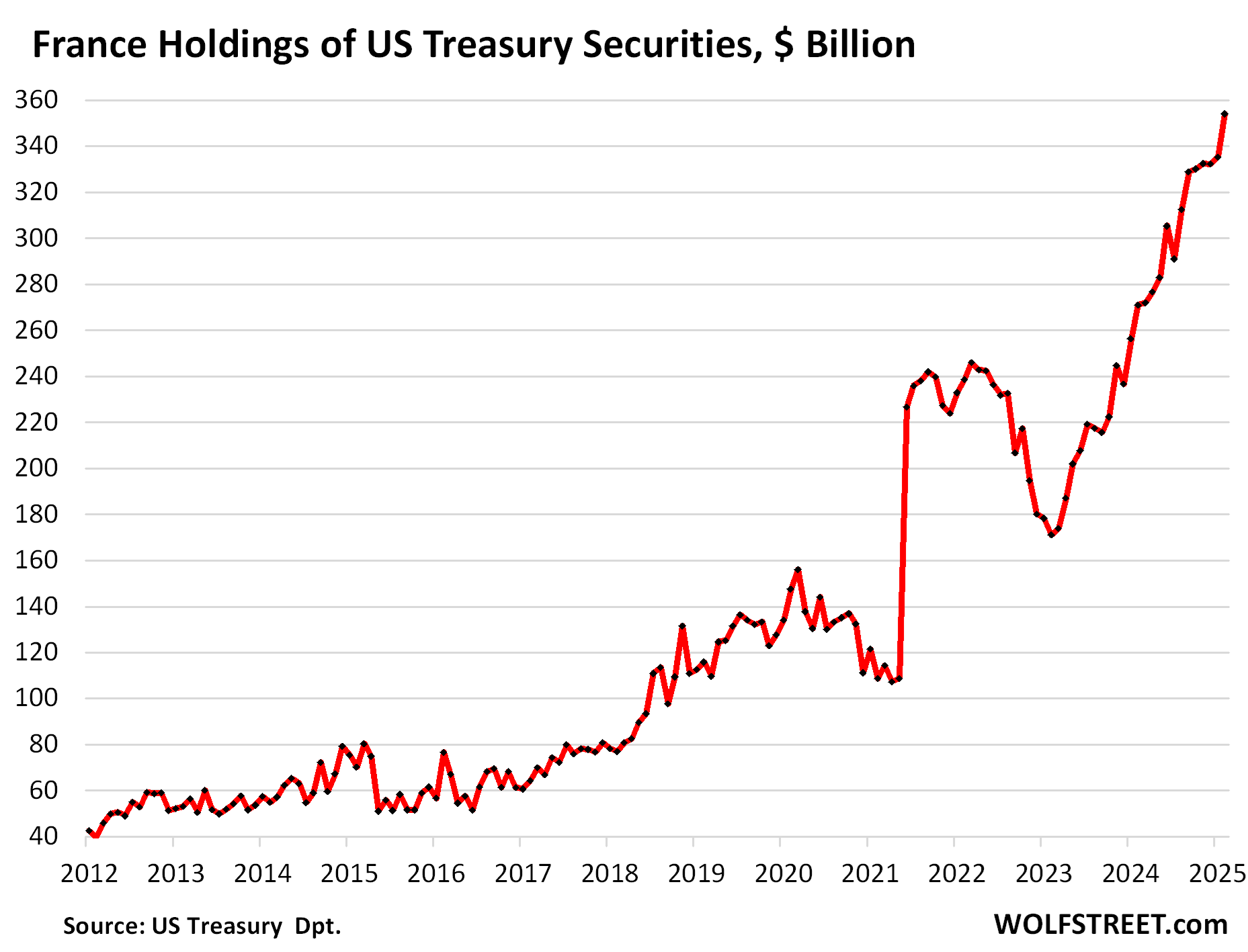
Taiwan’s holdings rose by $4 billion in February and by $37 billion year-over-year to a record $295 billion:
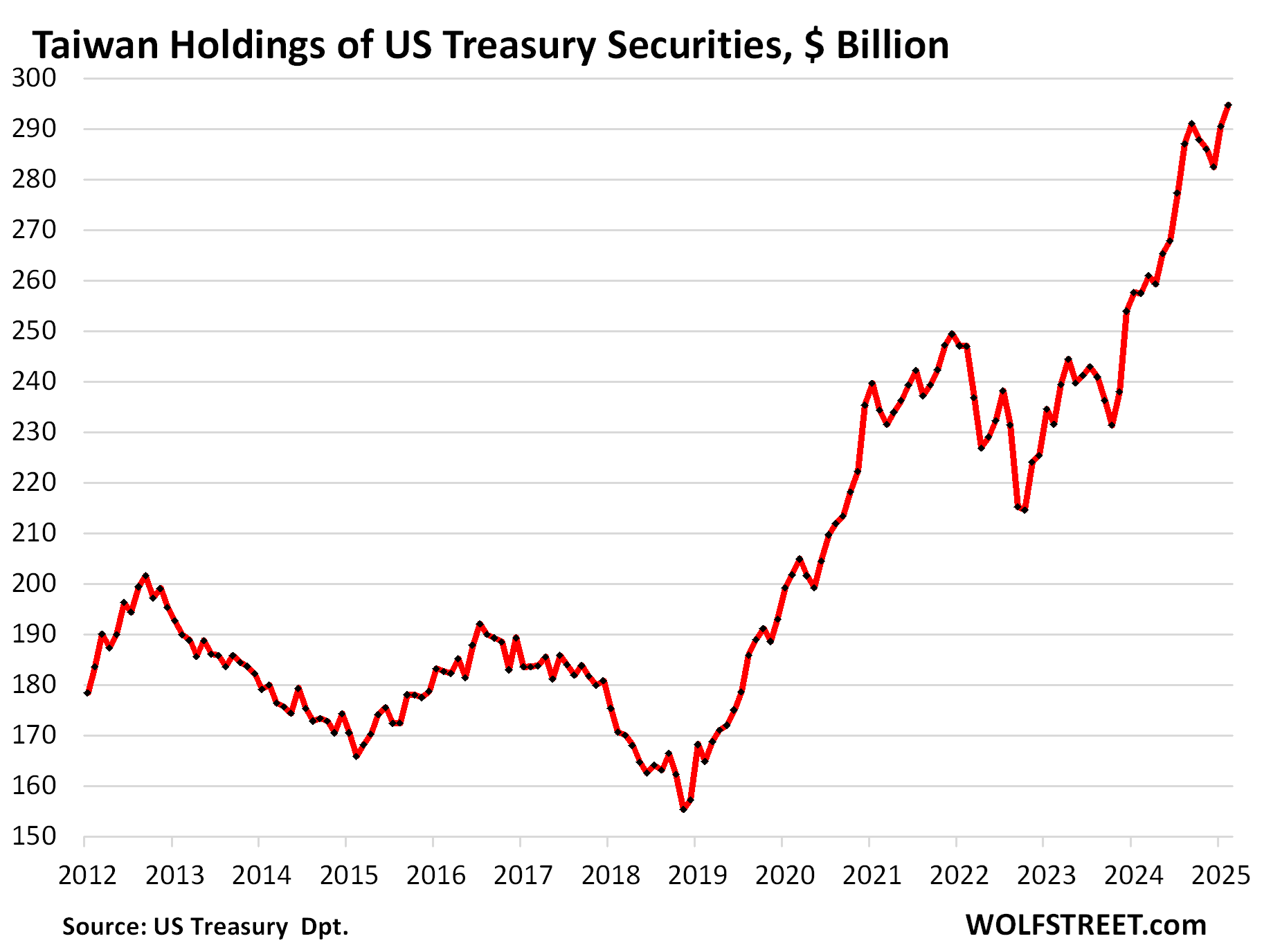
India added $2 billion in February, after three months of unloading, bringing its holdings to $228 billion, still down by $7 billion year-over-year. Since 2012, its holdings have sextupled:
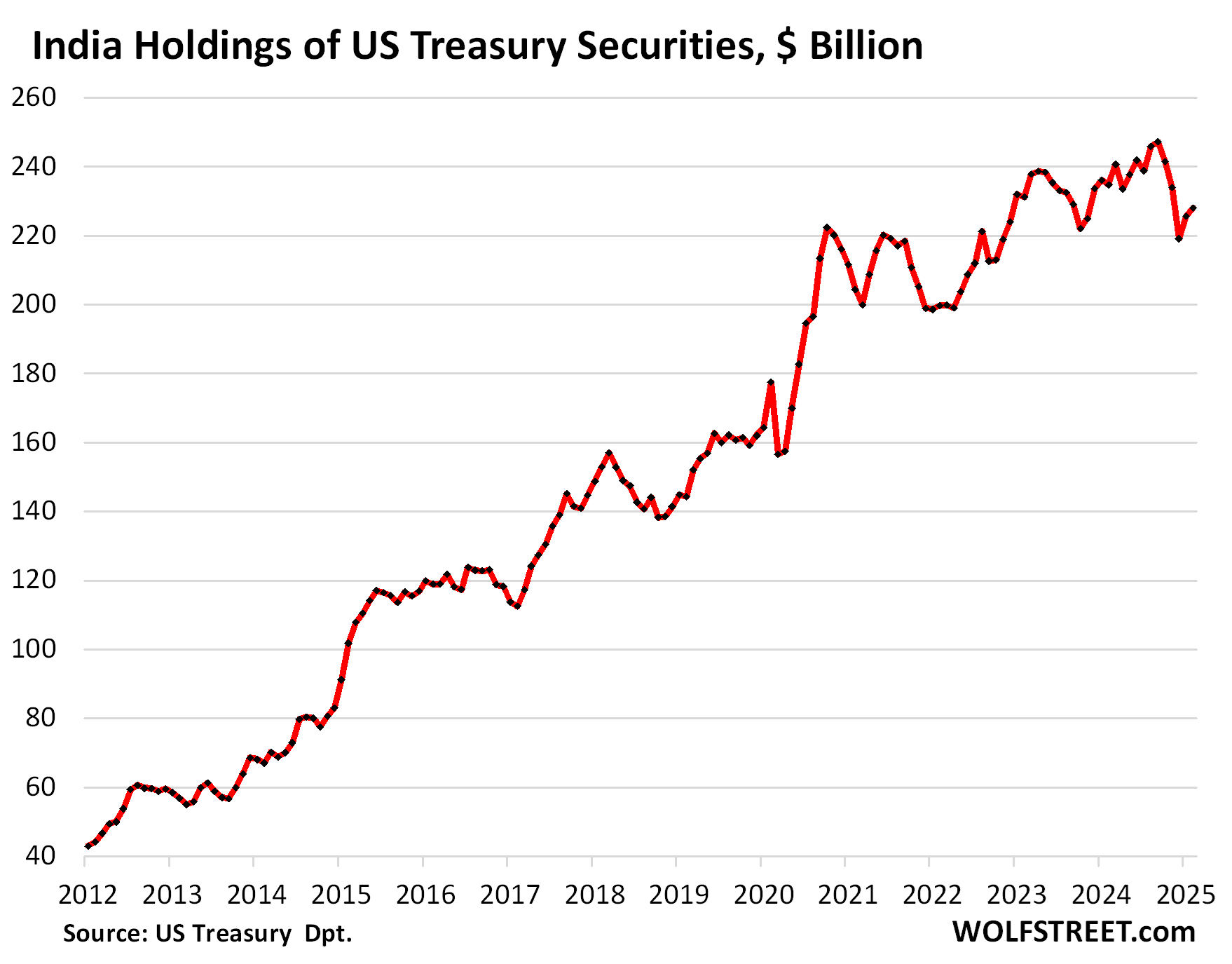
Even Brazil increased its holdings by $8 billion in February, to $207 billion, after relentlessly reducing its holdings for years in part to prop up the Brazilian real. From the peak in 2018, its holdings have fallen by 36%:
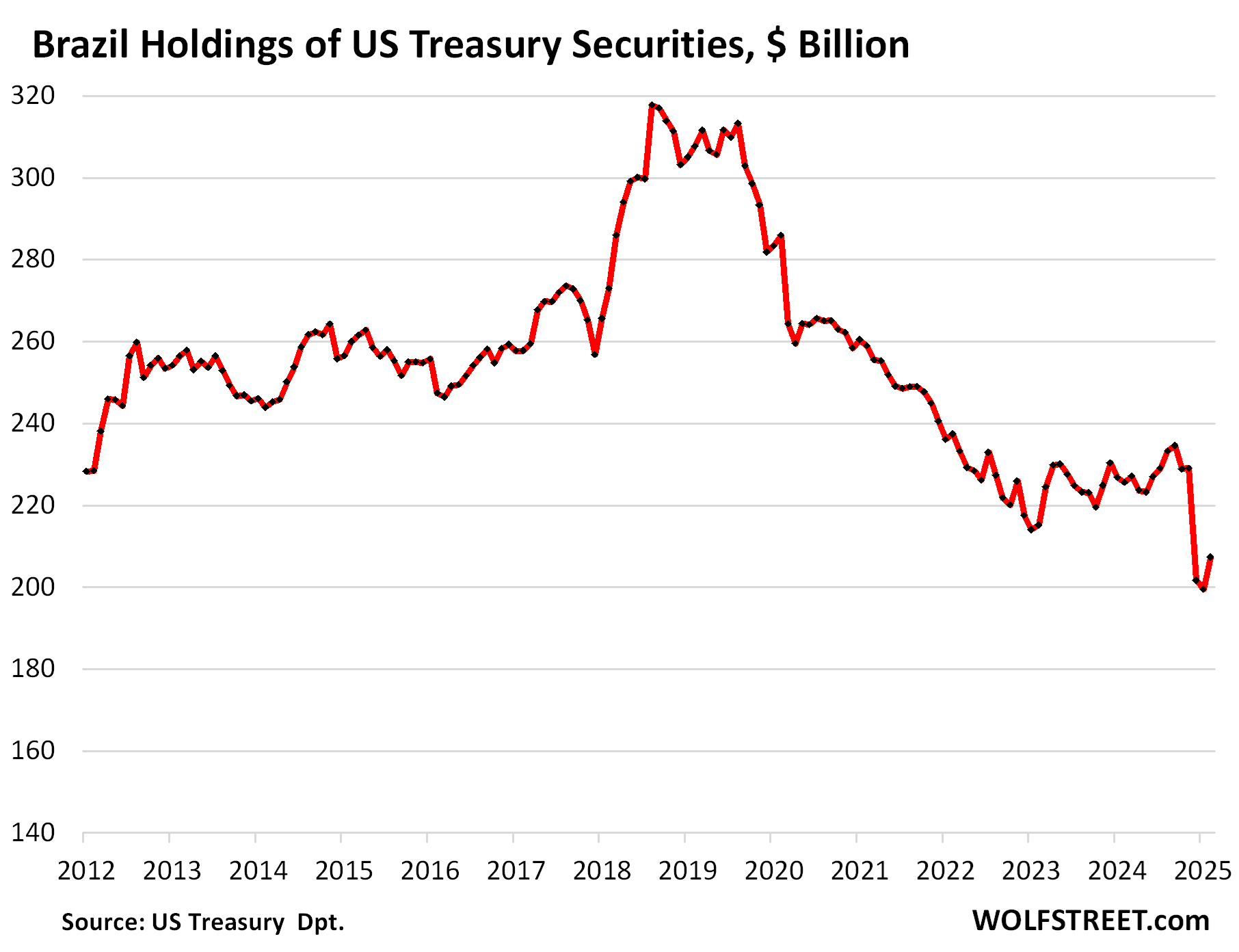
Enjoy reading WOLF STREET and want to support it? You can donate. I appreciate it immensely. Click on the mug to find out how:
![]()


Very interesting data. Thanks for posting. Sec. Bessent’s biggest problem is, IMO, rolling $9.25T of 2% avg coupon UST, this year. My stated opinion has been that the tariffs are a new weapon to help make this happen at a faster pace. Does that make sense to you, Wolf?
no, it doesn’t make any sense whatsoever. There has been huge demand for this type of debt at the past auctions, as I pointed out in the article. At this pace of demand, Bessent isn’t going to have any problems selling this debt. But the yield at which he sells it ain’t gonna be 2%. Yield solves all demand problems. In terms of the reasons for the tariffs, you just made up your own blue-sky conspiracy theory or something.
And all those Japanese buyers are looking at around 8 to 10% losses, if they didn’t hedge, on the increase in the value of the yen versus the dollar.
Currency risk is always a factor. Lots of Japanese buy foreign-currency securities to diversify away from the yen. Those that did a few years ago were very smart or lucky when the yen plunged against the dollar, and they had some of their money in dollar-denominated instruments.
Hey Wolf, Thanks for great data as always! The question I am getting these days is what spiked the yield on the 10 year from 4% on 4/3 to 4.5% on 4/11. One Bank of America analyst is saying it is partially from margin covering amongst hedge managers. What’s your take?
That’s a nonsense question. The question should be: What caused the 10-year yield to plunge in days to 4%? After the yield plunged to 4% it then snapped back, down in days, up in days, almost symmetrical, that’s all that happened, a fast roundtrip. It should have never plunged like that, and so the market figured it out and corrected the plunge.
I don’t know why I keep seeing the same questions over and over again. I guess some people don’t ever read anything here, neither the articles not the comments, and just come spread BS?
read this, I discussed this here
https://wolfstreet.com/2025/04/12/10-year-treasury-yield-snaps-back-to-februarys-4-5-yield-curve-re-un-inverts-mortgage-rates-back-at-7/
And this is the updated chart:
What source do you use to see the $9.25T that needs to be rolled over this year? I was trying to see the distribution of US debt by interest rate and when it needs to be renewed but couldn’t find a good source.
I wonder if these countries are now selling US Treasuries since Liberation Day. Is there any way to know that at this time? This data is two months old.
As I said in the article, there was very strong demand from foreign investors at the last three long-term bond auctions, at the 10-year and 30-year auctions last week, and at the 20-year auction today. You cannot get anymore current.
Total foreign holdings at the end of April will be released in two months. But they’re now buying hand over fist. Which is also why the 10-year yield is so low. It should be 5%-plus, it was 4.28% today.
Cannot understand buying USD at its peak,,,,they lost 13% already and usd trend Is DOWN
Curious if foreign governments able to borrow at lower rates are taking advantage of this situation. Borrow cheap money and invest at a guaranteed higher rate!
This info is dated – as in it predates the tariff fiasco. 10Y T interest rate has spiked since “liberation day” (if ever there was a misnomer). Expect 10Y T interest rate to continue upward as domestic and international confidence in US Gov’t decreases.
BS. Read the article. What does it say about foreign buying at recent bond auctions? Here is what it says:
“These higher yields for Treasury securities make them very attractive to foreign buyers. We saw that this buying continued at the 10-year and 30-year Treasury auctions last week, and at the 20-year Treasury auction today: There was blistering demand from “indirect bidders,” a category that includes foreign bidders.”
In other words, foreign buyers even today gobbled up long-term US debt. So don’t give me this stupid BS.
The 10-year yield is exactly where it was on March 28. It has dropped by 10 basis points this week. It’s now at 4.28%, it’s way too low because Bessent keep bashing it down. It should be 5%-plus, given where inflation is.
Read this and learn something:
https://wolfstreet.com/2025/04/12/10-year-treasury-yield-snaps-back-to-februarys-4-5-yield-curve-re-un-inverts-mortgage-rates-back-at-7/
I love Wolf – very experienced and knows his sh*t.
Don’t F with the Wolf!
How are the Wall Street patients holding up? Critical condition and mouth breathing?
Not well, really. The aged patient is fighting the inevitable outcome with each labored gasp.
Geez. You expect us to read the article before we form our opinions? That’s a awful lot of work!
Nice job, Wolf. Nobody does it better.
I can’t read! Except for your comment and proofreading my own
Are you frigging kidding? Who wants to buy a hot potato that’s gonna burn right through them like molten steel? Might as well take a cyanide pill and say ‘yummy.’
“Who wants to buy a hot potato that’s gonna burn right through them like molten steel?”
1. Mixed metaphor. But kind of cute.
2. The article tells you who bought them among foreign investors. So go ahead and read the article. It doesn’t bite. But US investors — including people here in the comments, and including me — have bought most of them. Turns out, they’re not hot potatoes, and they haven’t burned through anything yet like molten steel. But they do pay interest, and you get your money back when they mature, which is why people buy them.
3. And if you’re USian and live in a high-income-tax state, such as California, you don’t pay state income taxes on your interest income from Treasury securities, which is a nice feature.
Attractive? With a declining dollar? I do not understand it.
https://wolfstreet.com/2025/04/11/omg-the-dollar-is-collapsing-or-whatever/
This 1973 to 2025 chart really adds perspective on the dollar’s range. Thanks for re-inserting, Wolf. Superimposing the CMT10 yr Treasury would add flavor.
Nonetheless, that last downward squiggle represents a darn serious loss in value on his bond if purchased at the 110 DXY mark, wouldn’t it?
Those 30 year treasury buyers are piling on the volatility. Hope the buyers aren’t SIFI’s (or foreign equivalent) or we might be headed toward choppy waters, whitecaps, or worse.
Apologies for tortured wording above.
Question: are you worried much about systemic risks due to potential rate volatility combined with DXY volatility?
Thank you.
DXY around 100 seems to be about right, not too high, not too low. 80 was problematic, 115 was problematic in the other direction. When the DXY was designed in 1973, the initial index value (like many indices) was set at 100. And that’s where it is now.
Both US$ and DXY, when compared to “the-asset-formerly-known-as-money” (i.e. gold; apologies to Prince) have lost value massively when viewed on the timescale in the above chart (‘73-‘25), emphasizing the failure of technocratically managed monies.
The triple mandate — combined with rate fixing — is a prescription for chronic deficits, continual currency devaluation, and sporadic financial system crises, IMHO.
Time to re-imagine the Fed and what we ask it to do (hint: way too much).
Respectfully.
John H
I’m going to start deleting comments that confuse a currency with an asset. I’m really sick of this BS.
A currency is a measuring unit, such as “miles” or “square feet.” The dollar is a currency — and therefore a measuring unit. You don’t invest in dollars, you CANNOT invest in dollars, you invest in assets such as gold, real estate, stocks, bonds, loans to your bank (deposits), cryptos, etc. And the value of those assets is then expressed in some currency, such as dollars.
So you need to compare the value of gold to the value of other assets, and the value of these assets includes the interest and dividends and rents, etc. that they pay over time.
It all depends on what index you are using to measure the performance of the US dollar.
The Fed had another index which has been discontinued, but there is still the Nominal Broad US Dollar Index which was set at 100 in 2006. This index is sitting just under its all time high. Last data for Mach 2025 was around 126.
The recent fall in the DXY is a result of its narrow base and not really reflective of US trade.
https://fred.stlouisfed.org/series/TWEXBGSMTH
You said you can’t invest in dollars and it is a currency.
Well when Mrs Watanabe sells yen from her bank account and buys dollars with them and deposits them into her bank account she has invested in dollars.
When she sells the dollars for yen at some point in the future she will either have a capital gain or loss on those dollars as well as any interest income she may have received.
Nonsense. Watanabe doesn’t buy dollars. She invests in a loan (an asset for her) to her bank denominated in yen, and then she exchanges that loan (an asset for her) for a loan (an asset for her) denominated in dollars. There are no “dollars” in any bank account. There are only debts and credits denominated in a currency. If she buys “dollars” in the FX market, she doesn’t buy dollars but contacts denominated in dollars. Payment is debits and credits. People who read this site need to get a grip on what a currency is, and what debits and credits are, and what assets are.
Wolf –
I get your statement that “a currency is a measuring unit.” Similar to Lyn Alden’s concept of money as a ledger — keeping track of those debits and credits you mention.
Where I need clarification is the concept of currency devaluation — the process by which the money unit loses its ability to buy the stuff I need or want. (Food, shelter, clothing, means of transport, and services for example, and maybe various metals).
DXY is useful in comparing major currencies to each other, but at some point how the dollar performs against the yen or pound pales in importance compared to the loss in purchasing power of all debt currencies.
I appreciated the 1973 to present chart you supplied, but it fails to show the loss of purchasing power that all the currencies in the DXY have experienced over the last 50 years. The point I was trying to make was not that “money” is an investable asset, but that the manipulation of money as a unit of measure has resulted in the devaluation of the unit itself, and inflated the price for every asset that savings (denominated in that currency) can buy. Inflation of prices due to expansion of debt-backed money production.
An article on this subject would be worthwhile, especially with all of the currency experimentation (including crypto) over the past 20 years.
(Not intending to provoke. Thank you sincerely for your work.)
I dont either. Monumental shifts happening away from US. Lines have been crossed than can never be uncrossed, bonds destroyed that will take decades to rebond. So far the dollar might just undone some of the too-strong, but were below 100 and with no end in sight.
With a devaluating Dollar US Treasuries that give +1% point to any EUR bond beats me why they are called “attractive”.
I guess Wolf is still in the club at 5 am in the morning and just takes what he can get xD
You’re in Germany. So you should see what some USians here say about the euro, LOL.
Glorious News! The US can keep the peddle to the Metal and keep on printing. The gravy train is never ending. 40 trillion debt, no problem.
Do you remember the beer commercial where some guys were sitting around a campfire drinking beer and one says, “Boy’s, it don’t get no better than this.”
Enjoy! Money is plentiful.
No one is “printing.” the Fed is un-printing, and already un-printed $2.2 trillion (QT).
Man so many people are actively rooting against the US here
Yeah, it’s funny, isn’t it. It’s like their brain got polluted by the internet BS.
Yeah I wonder how much of wall street is actually smart sometimes lol
People tend to like their political biases and narratives more than facts on the ground.
Very true
So many without the ability to smile while eating a s*** sandwhich.
I know what you mean.
I can barely stand to read MSM financial outlets. Its all opinion. They never provide any data. All the comments are so anti-American. It makes me wonder how many are bots or trolls?
But the New York Times told me everyone was selling US assets…
The New York times also apologized for the hunter Biden laptop and COVID lockdowns. Doesn’t mean shit 5 years after the fact lol
Selling, like buying is personal. Selling overpriced assets ain’t such a tragedy.
So great when the actual data, beautifully displayed by you Wolfie, contradicts the narrative that foreigners are dumping US debt en masse. A question presented is if foreigners were buying, yet yields kept rising despite strong foreign demand, who was the net seller, and why did Swap spreads go negative…a relatively rare event? One possibility is that net sellers were hedge funds (directs), who were forced to unwind their 20x leveraged basis trades last week, keeping yields elevated notwithstanding strong foreign auction demand (indirects). Thoughts if convenient sir?
Yields plunged and shouldn’t have. So they snapped back. That’s all that happened. That happens a lot with everything:
https://wolfstreet.com/2025/04/12/10-year-treasury-yield-snaps-back-to-februarys-4-5-yield-curve-re-un-inverts-mortgage-rates-back-at-7/
Despite our problems, the United States are still the best bet in the world.
Also, people running into bonds and treasuries is fine. If you are 100% in stocks then lol but we’ll have to hear about “Muh 401k” like US equities are the only investment product.
Money dumping into the ten year is actually great news. Hopefully it keeps on happening.
I ran into stocks when they crashed. Of course there’s always the risk that there may be a further crash. My rationale, though, is that the US economy is fundamentally sound (and this site has helped me understand that) even in light of many flaws and problems in recent years. There’s no requirement for future stock massacres in light of this. Anyway, further crash is a risk I’ve accepted. I also keep some money in treasuries.
When I got home from working in a Chinese controlled environment I embraced the earth and thanked the deity I don’t believe in for the good old USA. And I thanked my mother that I was born here rather than in the country of my ancestors.
Realizing that America is the every day people.
Swap spreads blowing out, as they did last month, does not “happen a lot”. It’s actually pretty rare and a sign of something systemically wrong in the US debt market, when counterparty risk is priced lower than US full faith and credit.
US is the cleanest dirty shirt. That’s fine with me. Sounds like the shirt I usually wear. MSM has a lot people spooked. The Fed actually sounds reasonable (yikes!) so far.
These little ups and downs in the stock market are nothing compared to its upcoming crash. We haven’t had a stock market crash in 16 years. The stock market always crashes, we just don’t know when.
I wonder what would happen if US and foreigners started to really pile into T-bills (say, three month T-bills), where the rate is pretty much fixed by the Fed Funds Rate. By rate, I am looking at the “Investment Rate” which is what we get at auction as shown in Treasury News – Treasury Auction Results. And it is remarkably stable, varying about 4.28% to 4.33% weekly this year despite all the recent market turmoil. The “Low Rate” has also been pretty stable, around 4.10%. It doesn’t seem like much of an “auction”, if the Investment Rate is always pretty much the same each week.
Would the Fed ever lower the Fed Funds Rate because of an overwhelming demand for T-bills? Seems like this might violate their two mandates.
There was a very steep stock market crash in 2020. So it’s just over 5 years. There’s no reason it has to happen again soon, although it’s not impossible we could get another one sometime in the 2020s.
And the ~25% drop when the S&P went from 4700 (Nov 2022) to a bottom of 3600 (Oct 2023).
I’ve been told this never happened!!!!
Not under comrade Biden
The NASDAQ also had a very troubled period in 2022.
My life has been too helter-skelter for making bets about 10 years in the future. I did have one 30-year bet for buying a house, but paid it off in 5 years (rural southeast Colorado).
Ten years from now, at age 84, if I’m lucky, I’ll maybe be looking for a cute little self-driving electric vehicle designed for old people. Or if too many physical limitations at age 84, personal caretakers are very affordable here in Thailand (even for folks without the supposedly minimum needed one+ million dollars for retirement). Even with a great classic genuinely respectful and polite Thai caretaker, there will be no happy endings at that age, in any sense of the term.
So for now I’m sticking to laddered four week Treasuries.
It always strikes me as ironic that every single pension, 401k, index, & annuity is focused solely on stocks.
But the Bond market & Real estate markets both are twice as big as the stock market. Everyone glosses over that fact.
Correct me if I’m wrong, but the Federal Debt is $36 Trillion dollars. If I had $36 Trillion dollars I could buy every share on the DOW, NASDAQ, & RUSSEL 2000.
They make fun of me when I buy Treasuries, but I see I’m always in good company every auction. And I don’t get hit idiotic brokerage fees.
Wolf, who is the dumb money? Stocks or Bonds? Or both?
The capitalization of all US stock markets combined is $52 trillion. So you would need that much to own it all at current prices.
In terms of debt, there’s more than that. In addition to the $36 trillion in Treasury securities, there are also other federal government bonds, such as agency debt, then there are mortgage bonds (MBS) $11 trillion of them, plus commercial mortgage-backed securities (CMBS), plus corporate bonds, leveraged loans, municipal bonds, asset-backed securities, etc., all in all likely quite a bit larger than the $52 trillion in stock market capitalization.
Yes, there are lots of goods reasons to invest in bonds.
Ah yes, thanks for the reminder regarding all the other debt. There really is no such thing as a risk-free return. Definitely less risk buying T-bills with short duration, but predicting inflation and the true cost to due business or live comfortably ten years out is foolish IMO.
For me, the city municipalities are increasing property taxes again, and again I will fight them. Whatever increase they impose I will pass along to my tenants.
Interesting times.
I think this shows that any country buying these long term investments is basically saying they expect the US Dollar to be the top currency over the life of the bond.
Hi,
Apologies if this is a stupid question, I’m very far from an expert.
Shouldn’t the question be how the US compares to other bond markets? If the overall interest in bonds increases globally due to uncertainty in the market, shouldn’t we be looking at the relative change of US bonds versus other bond markets?
If you had read the article, you’d know the answer. So read the article!!! And I mean READ it, not just look at the pictures. I listed the 10-year yields of other bond markets, compared to the US, and explained that this yield differential is in part why foreigners keep buying US Treasuries.
So, there it is, the usual suspects are buying U.S. paper. The global south, not so much. Regardless, it appears that globally speaking, central bankers have all become stackers of physical gold.
Interesting times.
Central banks only own a very small amount of gold and it isn’t even worth counting as part of their reserves.
Yeah, sure.
Why do you come up with these ridiculous statements when it comes to gold?
Care to list how much gold is owned by various central banks and the respective values so we can judge what you term: “isn’t even worth counting”.
Can you tell the readers here what your problem is with gold ?
So basically every data release is “hard data fine, soft data bad” but you can literally go through the last 2 years and show that the soft data rarely lines up with reality
One of the most interesting things about this article is that, at least by implication, even the USA’s alleged enemies are betting on the long-term stability of the USA. Why would, for instance, several of the major BRICS nations all of a sudden pile into US treasuries after some years of declining commitment? They must feel that the relationship is not so fraught, or they wouldn’t have changed course like this. Anyway, I still expect geopolitical turmoil in the coming years, but this is not exactly what I thought would happen.
They could also be betting that rates will drop and that portfolio with increasing value and can be sold or used as leverage…
same as it ever was.
I wouldn’t bet on that unless inflation also goes down and so far it has been very persistent.
Not so much betting that inflation will go down and FRB lowers rates as that Trump will fire Powell and install his guy who will lower the rates.
Apparently that is already in the planning stage.
When did the Bank of Canada dump its gold holdings in favor of US Treasuries?
Federal Court finds Google advertising is an illegal monopoly, in violation of Sherman antitrust act.
U.S. v. Google, 23-cv-00108, U.S. District Court, Eastern District of Virginia (Alexandria)
MW: Trump Says Powell’s ‘Termination’ Can’t Come Soon Enough in Latest Push Against Fed Independence
MW: ECB’s Lagarde: ‘I have a lot of respect for my esteemed colleague and friend Jay Powell’
Europe’s top central banker responds to the apparent Trump threat to Fed chief Powell’s position after ECB cuts rates.
MW: Mortgage Rates Jump the Most in a Year.
Really interesting data and presentation.
With the debt ceiling in place since January, doesnt that limit the supply of debt entering the markets. Decreased supply, higher price (lower yield ?).
When the debt ceiling is raised or eliminated, then lots of new supply will come in. What then ?
Simultaneously gold has been steadily up. Up $100 yesterday alone – that kind of move used to take weeks.
I remind myself that real data is often choppy. Rarely proceeds along a smooth curve.